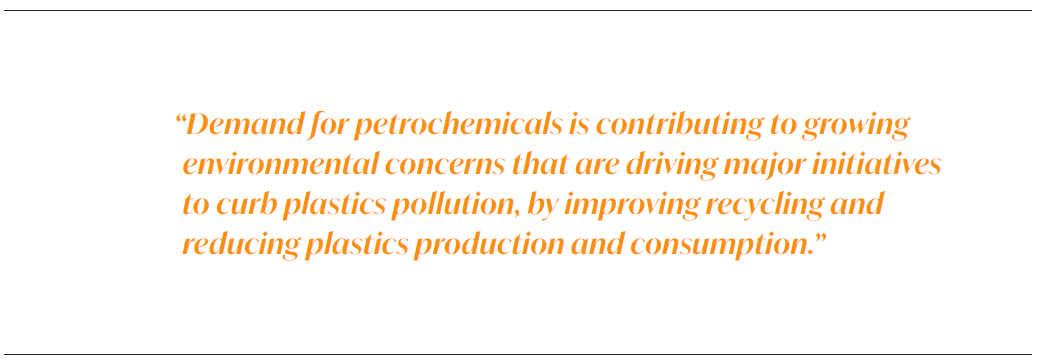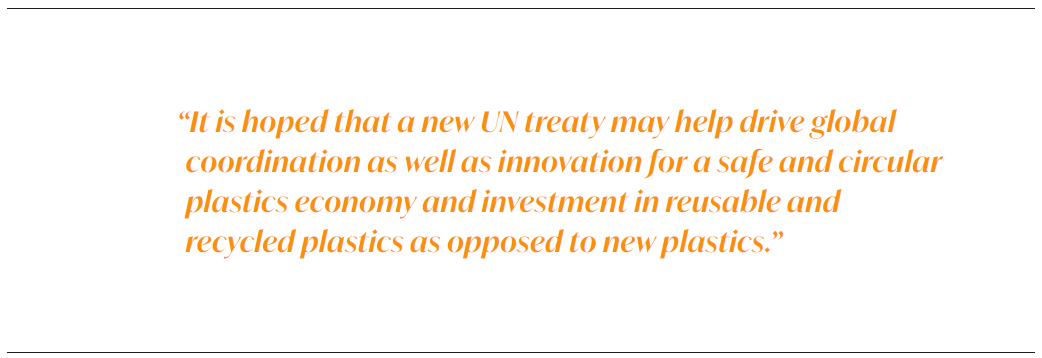Rising demand for plastics to drive oil and gas use in 2023 [Gas in Transition]
The demand for oil and gas continues to increase despite outlooks produced by the International Energy Agency (IEA) that show it peaking over the next few years. A contributor to this is the rising demand for plastics globally.
Growing populations and rising GDP and prosperity are boosting demand for petrochemicals. But this is contributing to growing environmental concerns that are driving major initiatives to curb plastics pollution, by improving recycling and reducing plastics production and consumption.
Plastics consumption by 2050
Plastics consumption increased by 400% since the 1980s and it is still rising exponentially. By 2025, plastic production is expected to exceed 600mn metric tons/year and then double by 2050. Another staggering statistic is that more than half of all plastics produced so far were made since the year 2000.
This growing demand for plastics is driving global oil and gas demand and it is expected to offset reductions due to the transition away from fossil fuels. IEA’s Future of Petrochemicals report in 2018 identified petrochemicals as the sector rapidly becoming the largest driver of global oil demand. No wonder then that the importance of petrochemicals to the oil and gas industry is on the rise.
Bloomberg NEF (BNEF) estimates that, despite increasing transport fuel efficiency and the rapid growth of EVs, by 2050 20% of global oil demand will go into the production of petrochemicals.
And it is a lucrative business. In 2021 the global petrochemicals market was close to $600bn and it is expected to exceed $760bn by 2026. Asia-Pacific was the largest region, with the Middle East second. Plastic consumption growth is led by China and India. BNEF forecasts that Asia will account for over 60% of the increase in oil-derived petrochemical feedstock demand by 2050.
Earlier in January, the US Energy Information Administration (EIA) released its Short Term Energy Outlook. This shows global oil demand increasing to an all-time-high of 102.2mn barrels/day by 2024, with no sign of peaking demand.
In fact, as Bloomberg points out, no reliable short-term forecast shows that peak oil demand will happen soon. “Only long-term models — rather than forecasts — point to a peak within the next few years.” A contributory factor to this is the “rising consumption of oil feedstock used in the petrochemical industry to produce plastics.”
Oil majors and oil and gas producers such as the US, Saudi Arabia, the UAE and Qatar are investing in petrochemical projects, focusing on plastics and the Asian and African markets, where they expect demand to continue increasing. China is by far the biggest importer.
Despite a huge drive to develop sustainable petrochemical alternatives, such as bio-based plastics, these are at a very early stage and much more expensive than fossil fuel-derived products.
Petrochemicals sector developments
The US has a massive and integrated petrochemical industry, benefiting from a vast oil, gas and ethane resource base, making it highly competitive globally. The US is also home to many industry leaders such as ExxonMobil, Dow, CPChem, Eastman Chemical and many others.
But the world’s largest petrochemicals company by revenue is China Petroleum & Chemical Corp (Sinopec), closely followed by PetroChina Co. Ltd. These two stand out. They are followed by ExxonMobil, Shell and TotalEnergies.
Globally, 1,292 petrochemicals projects are expected to start operations during the 2022 to 2026 period. Of these, 1,137 are new-build projects and 155 are expansions of existing projects. The region with the fastest growth in petrochemicals production, and clear commitments and strategies to ramp up this growth in future, is the Middle East.
 One of the latest petrochemicals projects to be sanctioned recently is a 2.1mn mt/yr ethylene plant in Ras Laffan, including two polyethylene trains with a combined output capacity of 1.7mn mt/year, estimated to cost $6bn. This will be built by QatarEnergy, partnered by Chevron Phillips, and will be QatarEnergy’s largest investment in petrochemicals in Qatar, spearheading its downstream expansion strategy.
One of the latest petrochemicals projects to be sanctioned recently is a 2.1mn mt/yr ethylene plant in Ras Laffan, including two polyethylene trains with a combined output capacity of 1.7mn mt/year, estimated to cost $6bn. This will be built by QatarEnergy, partnered by Chevron Phillips, and will be QatarEnergy’s largest investment in petrochemicals in Qatar, spearheading its downstream expansion strategy.
This was one of a number of petrochemical projects announced recently by national oil companies in the Middle East.
In December Saudi Aramco and TotalEnergies agreed to proceed with the Amiral ethylene complex in Saudi Arabia, estimated to cost $11bn, with capacity to produce 1.65mn mt/year. In Saudi Arabia also, Advanced Petrochemical and Korean SK Gas are developing an 800,000 mt/yr propane dehydrogenation/polypropylene (PDH/PP) complex at Jubail, that will include an 843,000 mt/yr PDH plant to produce feedstock for two 400,000 mt/yr polypropylene plants, as well as a 70,000 mt/yr isopropanol (IPA) unit.
In November 2022, Saudi Arabia's Energy Minister, Prince Abdulaziz bin Salman, announced that Saudi Basic Industries Corporation (SABIC) plans to partner with Saudi Aramco to launch Saudi Arabia’s first crude oil and petrochemicals project in the city of Ras al-Khair with a production capacity of 400,000 b/d. This will be the world's largest crude oil refining chemical plant and the first of its kind in Saudi Arabia. It is part of a strategy to diversify the country’s economy from oil exports to the development of high-quality industrial products.
The ‘Saudi Petrochemical Strategy’ aims to convert about 4mn b/d of Saudi Aramco’s crude oil and liquids into petrochemical products to support the growth of Saudi Arabia’s petrochemical industry. It is also aiming to “expand and increase demand for petrochemicals in the global market by partnering with several countries, including India, China, the UK and others.” It will require “the development of some 100sq.km of industrial land in the cities of Jubail, Yanbu, Ras Al-Khair and Jizan, as well as the construction of new oil export facilities in Ras al-Khair and to increase the country's oil production to 13mn b/d.”
A report by GlobalData states that “petrochemicals projects dominate Saudi Arabia’s current pipeline of oil and gas programmes, accounting for around 60% of the projects anticipated to start during the 2022-26 period.” As many as 37 new, major, petrochemicals projects are expected to begin operations by 2026.
In support of this strategy, in 2020 Saudi Aramco acquired a 70% stake in SABIC, one of the world’s largest petrochemicals manufacturers, with facilities in the US, Europe, the Middle East and Asia-Pacific.
Associated with this initiative, Saudi Aramco is expanding its petrochemicals business in China. Among other projects, it signed a memorandum of understanding with China’s Shandong Energy Group on 9 December to collaborate on “integrated refining and petrochemical opportunities” in China’s eastern region. The company also signed a framework agreement with Chinese chemicals major Sinopec to build a Phase II refining and petrochemical complex in Fujian province.
Saudi Aramco is also expanding its operations in South Korea.
The Indian petrochemical market is expected to witness a significant expansion in response to strong market fundamentals and rapid growth in petrochemical demand. But industry leaders are pointing out the need for clear policies, including easing regulatory barriers, to accelerate domestic production.
Environmental concerns
The constantly growing mountain of plastic waste globally is causing serious environmental concerns. About 40% of plastic products end-up as garbage within a month after they are produced. It is estimated that the world is consuming about one million plastic bottles every minute.
So far, only about 6% of plastic production comes from recycled materials, perhaps because new, ‘virgin’, plastic produced by the oil and gas industry is so plentiful and cheap.
According to OECD, of the plastics that do not get reprocessed and reused, 19% are incinerated, 50% end up in landfills, and 22% end up being burned in open pits or pollute the environment. Plastics have been found “at the top of Mount Everest and at the bottom of the Marianas Trench.”
The UN environment programme estimates that plastics account for nearly 85% of marine pollution.
The debate about how to deal with plastic pollution is fierce. The plastics industry says that better recycling and waste collection is the answer, but others are pushing for placing caps on plastic resin production. The US, which is “the world’s top per capita single-use plastic polluter and home to several of the world’s largest chemicals companies”, suggests that “countries should be given the flexibility to develop national action plans that work best for them.”
The EU issued a Directive on Single-use Plastics in 2019 that took effect recently. This aims to reduce the amount of virgin plastic produced. It “promotes circular approaches that give priority to sustainable and non-toxic reusable products and re-use systems rather than to single-use products, aiming first and foremost to reduce the quantity of waste generated.” It also commits the EU to “play its part in preventing and tackling marine litter and aim to be a standard setter for the world.” The objective is to ensure that by 2030 all plastic packaging placed on the EU market is re-usable or easily recycled. But the Directive also recognizes that “the high functionality and relatively low cost of plastic means that this material is increasingly ubiquitous in everyday life” and that “plastic plays a useful role in the economy and provides essential applications in many sectors.”
EU’s environment commissioner, Virginijus Sinkevicius, agreed that "It is naive to think that just recycling is going to help. We need to start first of all with prevention measures."
The EU Directive requires that by 2025 all beverage bottles made of PET plastic must contain at least 25% recycled content and bans a wide variety of single-use products. Eventually this will have a wider impact, outside the EU. The need to deal with plastic pollution is a key part of the argument for transitioning to a circular economy.
BNEF’s Advanced Circular Economy Scenario, which assumes “an acceleration of recycling, lower consumption of single-use plastics and increased use of bio-based feedstocks”, shows that the growth in oil demand can be very much slowed. It finds that through implementation of such measures as much as 7.7mn b/d of oil demand could be avoided by 2050.
However, Chatham House points out that “a future entirely without plastic is neither realistic nor desirable. Petrochemicals are good at what they do in terms of lightweight flexibility, durability, versatility. But the world should aim for a future of drastically reduced plastic consumption and elimination of plastic pollution.” Ultimately, the world should aim for a future without plastic waste and pollution.
In February 2022, the UN Environment Assembly agreed to create a legally binding treaty to stop the global plastic pollution crisis, covering both the production of plastics as well as recycling. It is hoped that the treaty may also help drive global coordination as well as innovation for a safe and circular plastics economy and investment in reusable and recycled plastics as opposed to new plastics.



